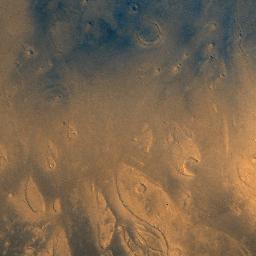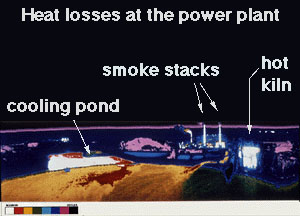Earth
The following table and aerial views contain a brief, side by side comparison of the two planets Earth and Mars. For a more detailed discussion of the surface and atmosphere of Mars try the Exploratour of the Surface of Mars, and The Evolution of Mars.

A terrestrial alluvial fan formation showing water draining from the mountains.
Leave the tour and read more about terrestrial floodplains & drainage systems.
Click on image for full size (55K jpeg)
Image courtesy of C. Alexander
Earth
-
Early Earth
- dense atmosphere with carbon dioxide and other molecules
- water oceans
- volcanoes & plate tectonics release more molecules
- Middle Earth
- life changes the content of the atmosphere to oxygen and nitrogen
- plate tectonics continue
- volcanoes continue to release molecules into the atmosphere
- Present Earth
- lots of oxygen, but increased carbon dioxide in the air
- climate changes with ice ages, etc.
- plate tectonics continue
- volcanoes continue to release molecules into the atmosphere
|

A Viking image of the floodplain on which the Mars Pathfinder landed.
Leave the tour and read more about Viking or the expectations of the Mars Pathfinder mission.
Click on image for full size (55K jpeg)
Image courtesy of NASA
Mars
-
Early Mars
- lots of carbon dioxide in the air, and some water on the ground
- volcanoes erupt, releasing more air
- Middle Mars
- the air starts to drift away
- volcanoes stop erupting
- Mars begins to freeze but experiences climate changes which allow water to run on the surface.
- Present Mars
- almost no air at all
- frozen ground
- there may be changes in the climate which allow water to run on the surface, but we don't know.
|
 Read more about the slow build up of oxygen in Earth's atmosphere
Read more about the slow build up of oxygen in Earth's atmosphere
This is page 8 of 20
 Read more about the slow build up of oxygen in Earth's atmosphere
Read more about the slow build up of oxygen in Earth's atmosphere













